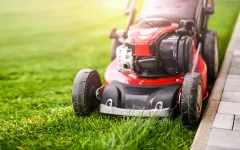Here’s how you can tell if you’re cutting your grass too short
Mowing the lawn can be quite a satisfying chore. The smell of freshly cut grass and the striped appearance once you’ve finished can make the task feel more than worthwhile. However, did you know that cutting the grass too short can actually do more harm than good?
Cutting more length off your grass than necessary might seem like a time-saving hack — after all, you can wait longer before mowing it again, right? But, the sad truth is you’re likely just damaging your lawn’s health, and causing yourself more issues in the future. If you’re unsure whether you’re guilty of this habit, here are 7 signs that you’re cutting your grass too short, and why you should stop now.
Be sure to also check out 7 lawnmower mistakes you’re probably making right now.
1. The health of your lawn suffers
First of all, the health of your lawn will deteriorate in general if you’re cutting the grass too short. Each blade of grass is part of a plant, and just like any other plant, it uses photosynthesis to generate nutrients.
According to the landscaping experts at Toolstation(opens in new tab), grass absorbs “energy from the sun, along with carbon dioxide and water, to create nutrients. Cutting your grass too short will reduce the amount of sunlight it can trap — limiting the amount of food it can produce for itself.”
As a result, your grass won’t have access to sufficient nutrients, so its growth will suffer. It will eventually appear more thin and sparse, rather than thick and lush, and you might find yourself having to apply more fertilizer than necessary to give it adequate nutrients.
2. Weeds are abundant
If your lawn is thin and weak, this unfortunately will make it more vulnerable to weeds, such as crabgrass and dandelions. When grass is limited, there will likely be more space in the soil for weed seeds to germinate, and because the grass is stressed, it won’t have the energy to fight off these unwelcome visitors.
In fact, grass which is cut too short will focus its energy on recovering and growing the leaves, rather than deepening the root system. As a result, it will be much weaker against any impending weeds.
3. Insects move in
Along with the weeds, you need to be aware of insects as well. While everyday insects can be a good thing for a healthy lawn, some can cause extensive damage while your grass is weak, particularly if your yard suffers from an infestation. Grubs which feed on grass roots, such as billbugs and white grubs, can be fatal if they move in.
A healthy lawn will be less susceptible to these infestations and will require fewer applications of insecticides as a result.
4. Brown patches of grass
If your grass appears brown in places, you need to ease up with the lawn mower. The stem of the grass is actually brown in color, and that’s potentially what you’re looking at here.
The experts at Toolstation continue: “Brown patches are another indication that you’ve cut your lawn too short. These suggest you’ve cut into the crown or growing point and killed some of the plants.
Usually, these patches recover on their own. For more severe patches, avoid fertilizing to begin with. Be patient and keep your lawn well-watered. Only feed it once it’s regained its strength.”
So, if you spot brown patches, you should definitely increase the height setting on your lawn mower, otherwise you could be killing your turf.
5. Diseases are frequent
While mowing your lawn to the correct height can help fend off some diseases, if you cut it too short and weaken your grass, that unfortunately makes it more susceptible. Healthy grass will have more energy to fight off everyday diseases, but weakened grass will struggle.
This means even if your grass survives everything so far, in its current state it could be finished off by a common fungal disease such as Red Thread or Summer Patch.
6. The heat is a killer
The heatwaves have been hard enough on our drought-tolerant plants, let alone our backyards. And add to that, if the grass is cut too short, things are only made worse. Grass which is too short and consequently sparse won’t provide adequate shade for the crowns. The crowns are then overly exposed to sunlight, which can cause a lot of stress.
The experts at Toolstation advise: “you’ll want to look out for wilting, especially after warm weather. Warning signs include brown blades cropping up among the green ones. If you know a heatwave is on its way, let your grass grow out a little. Longer grass is more resilient to the heat.”
7. Mowing the lawn in a rush
If you mow the lawn in a hurry, you can end up cutting areas much shorter than you intend. This is especially the case if you’re dealing with uneven terrain and stick to one setting.
Toolstation continues: “Uneven ground can make [mowing] tricky – meaning high points often look a little bare, while dips in the lawn can be especially lush.”
If your ground is uneven, you should take the time to adjust the settings on your lawn mower to suit the level of the terrain. Otherwise, some sections will end up scalped and cut much shorter than others.
What height should you cut your grass?
The ideal height will often depend on the type of grass you have as well as your climate. However, as a rule of thumb, you should cut your grass down to 2 ½ to 3 inches for best results, removing no more than one-third of the grass length at a time. This is a healthy height which will provide enough shade on the soil to retain water and fend off weeds.




















